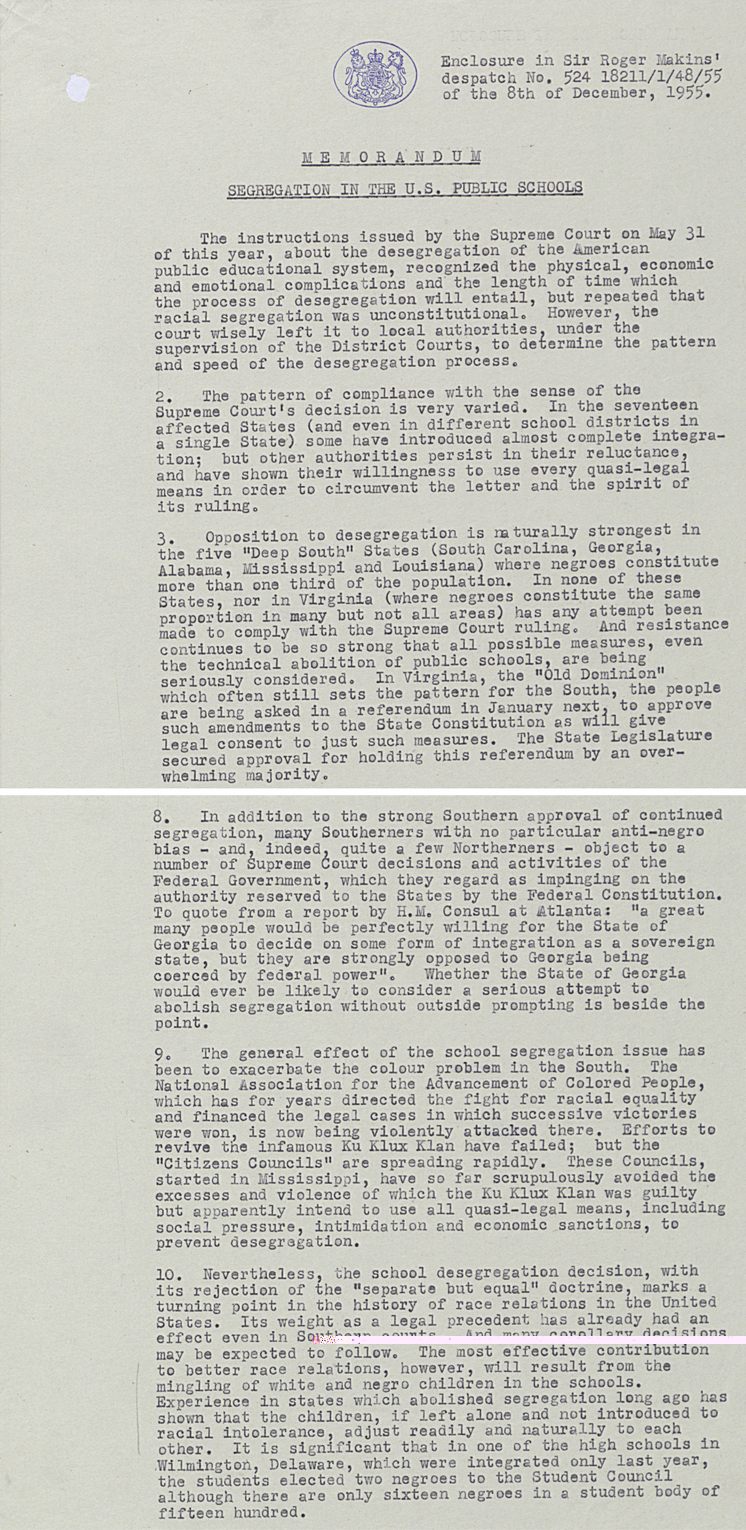
Memo from British Ambassador on segregation in US public schools, 8 December 1955 (FO 371/114445)
Transcript
Enclosure in Sir Roger Makins’ despatch No. 524 18211/1/48/55 of the 8th of December, 1955.
MEMORANDUM
SEGREGATION IN THE U.S. PUBLIC SCHOOLS
The instructions issued by the Supreme Court on May 31 of this year, about the desegregation of the American public educational system, recognized the physical, economic and emotional complications and the length of time which the process of desegregation will entail, but repeated that racial segregation was unconstitutional. However, the court wisely left it to local authorities, under the supervision of the District Courts, to determine the pattern and speed of the desegregation process.
2. The pattern of compliance with the sense of the Supreme Court’s decision Is very varied. In the seventeen affected States (and even in different school districts in a single State) some have introduced almost complete integration; but other authorities persist in their reluctance, and have shown their willingness to use every quasi-legal means in order to circumvent the letter and the spirit of its ruling.
3. Opposition to desegregation is naturally strongest in the five “Deep South” States (South Carolina, Georgia, Alabama, Mississippi and Louisiana) where negroes constitute more than one third of the population. In none of these States, nor in Virginia (where negroes constitute the same proportion in many but not all areas) has any attempt been made to comply with the Supreme Court ruling. And resistance continues to be so strong that all possible measures, even the technical abolition of public schools, are being seriously considered. In Virginia, the “Old Dominion” which often still sets the pattern for the South, the people are being asked in a referendum in January next, to approve such amendments to the State Constitution as will give legal consent to just such measures. The State Legislature secured approval for holding this referendum by an overwhelming majority.
…
8. In addition to the strong Southern approval of continued segregation, many Southerners with no particular anti-negro bias – and, indeed, quite a few Northerners – object to a number of Supreme Court decisions and activities of the Federal Government, which they regard as impinging on the authority reserved to the States by the Federal Constitution. To quote from a report by H.M. Consul at Atlanta: “a great many people would be perfectly willing for the State of Georgia to decide on some form of integration as a sovereign state, but they are strongly opposed to Georgia being coerced by federal power”. Whether the State of Georgia would ever be likely to consider a serious attempt to abolish segregation without outside prompting is beside the point.
9. The general effect of the school segregation issue has been to exacerbate the colour problem in the South. The National Association for the Advancement of Colored People, which has for years directed the fight for racial equality and financed the legal cases in which successive victories were won, is now being violently attacked there. Efforts to revive the infamous Ku Klux Klan have failed; but the “Citizens Councils” are spreading rapidly. These Councils, started in Mississippi, have so far scrupulously avoided the excesses and violence of which the Ku Klux Klan was guilty but apparently intend to use all quasi-legal means, including social pressure, intimidation and economic sanctions, to prevent desegregation.
10. Nevertheless, the school desegregation decision, with its rejection of the “separate but equal” doctrine, marks a turning point in the history of race relations in the United States. Its weight as a legal precedent has already had an effect even in Southern courts. And many corollary decisions may be expected to follow. The most effective contribution to better race relations, however, will result from the mingling of white and negro children in the schools. Experience in states which abolished segregation long ago has shown that the children, if left alone and not introduced to racial intolerance, adjust readily and naturally to each other. It is significant that in one of the high schools in Wilmington, Delaware, which were integrated only last year, the students elected two negroes to the Student Council although there are only sixteen negroes in a student body of fifteen hundred.
